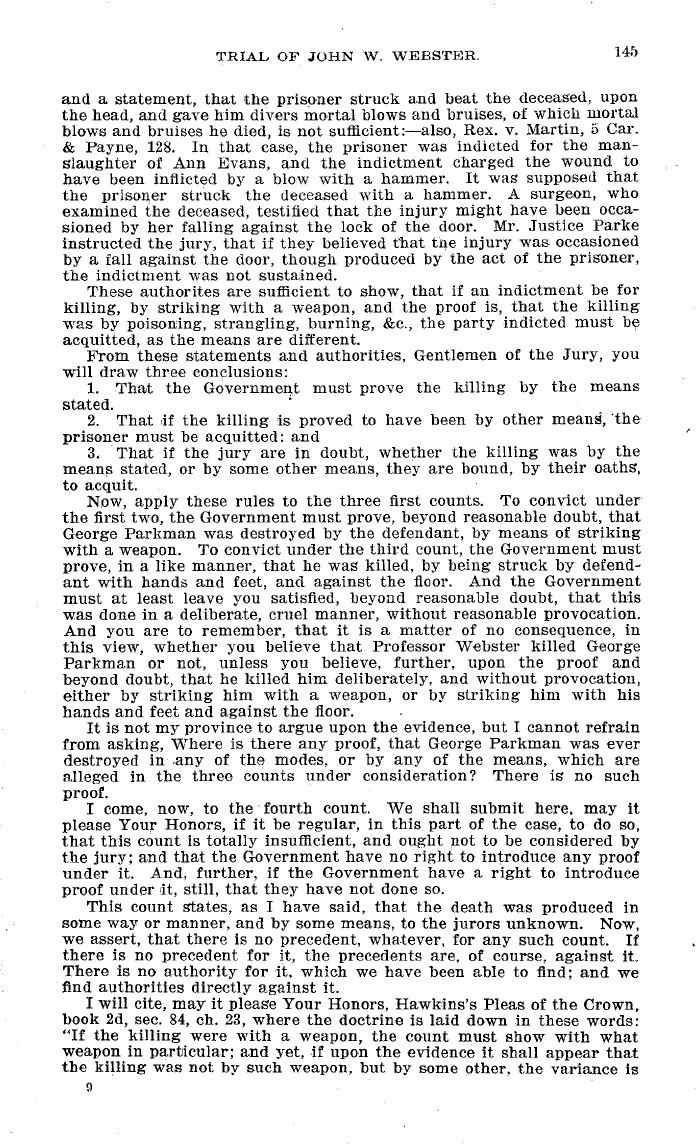|
TRIAL OF JOHN W. WEBSTER. 145
and a statement, that the prisoner struck and beat the deceased, upon
the head, and gave him divers mortal blows and bruises, of which mortal
blows and bruises he died, is not sufficient: also, Rex. v. Martin, 5 Car.
& Payne, 128. In that case, the prisoner was indicted for the man-
slaughter of Ann Evans, and the indictment charged the wound to
have been inflicted by a blow with a hammer. It was supposed that
tire prisoner struck the deceased with a hammer. A surgeon, who
examined the deceased, testified that the injury might have been occa-
sioned by her falling against the lock of the door. Mr. Justice Parke
instructed the jury, that if they believed that the injury was occasioned
by a fall against the door, though produced by the act of the prisoner,
the indictment was not sustained.
These authorites are sufficient to show, that if an indictment be for
killing, by striking with a weapon, and the proof is, that the killing
was by poisoning, strangling, burning, &c., the party indicted must be
acquitted, as the means are different.
From these statements and authorities, Gentlemen of the Jury, you
will draw three conclusions:
1. That the Government must prove the killing by the means
stated.
2. That .if the killing is proved to have been by other means, 'the
prisoner must be acquitted: and
3. That if the jury are in doubt, whether the killing was by the
means stated, or by some other menus, they are bound, by their oaths,
to acquit.
Now, apply these rules to the three first counts. To convict under
the first two, the Government must prove, beyond reasonable doubt, that
George Parkman was destroyed by the defendant, by means of striking
with a weapon. To convict under the third count, the Government must
prove, in a like manner, that he was killed, by being struck by defend-
ant with hands and feet, and against the floor. And the Government
must at least leave you satisfied, beyond reasonable doubt, that this
was done in a deliberate, cruel manner, without reasonable provocation.
And you are to remember, that it is a matter of no consequence, in
this view, whether you believe that Professor Webster killed George
Parkman or not, unless you believe, further, upon the proof and
beyond doubt, that he killed him deliberately, and without provocation,
either by striking him with a weapon, or by striking him with his
hands and feet and against the floor.
It is not my province to argue upon the evidence, but I cannot refrain
from asking, Where is there any proof, that George Parkman was ever
destroyed in .any of the modes, or by any of the means, which are
alleged in the three counts under consideration? There is no such
proof.
I come, now, to the fourth count. We shall submit here, may it
please Your Honors, if it be regular, in this part of the case, to do so,
that this count is totally insufficient, and ought not to be considered by
the jury; and that the Government have no right to introduce any proof
under it. And, further, if the Government have a right to introduce
proof under .it, still, that they have not done so.
This count states, as I have said, that the death was produced in
some way or manner, and by some means, to the jurors unknown. Now,
we assert, that there is no precedent, whatever, for any such count. If
there is no precedent for it, the precedents are, of course, against it.
There is no authority for it, which we have been able to find; and we
find authorities directly against it.
I will cite, may it please Your Honors, Hawkins's Pleas of the Crown,
book 2d, sec. 84, ch. 23, where the doctrine is laid down in these words:
"If the killing were with a weapon, the taunt must show with what
weapon in particular; and yet, if upon the evidence it shall appear that
the killing was not by such weapon, but by some other, the variance is
|

